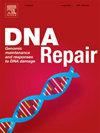To divide or not to divide? NAC8 (SOG1) as a key regulator of DNA damage response in barley (Hordeum vulgare L.)
IF 2.7
3区 生物学
Q2 GENETICS & HEREDITY
引用次数: 0
Abstract
We identified several new TILLING mutants of barley (Hordeum vulgare L.) with missense mutations in the HvNAC8 gene, a homolog of the SUPPRESSOR OF GAMMA RESPONSE 1 (SOG1) gene in Arabidopsis thaliana. In Arabidopsis, SOG1 is the primary regulator of the DNA Damage Response (DDR) pathway. We aimed to transfer this knowledge to barley, an agriculturally important crop. Our detailed analysis of the hvnac8.k mutant revealed an impaired DDR pathway. The hvnac8.k mutant accumulates DNA damage under genotoxic stress induced by zeocin, but it also shows increased DNA damage under normal growth conditions. Despite this, the frequency of dividing cells in the root meristem of the mutant treated with zeocin is much less affected than in the wild type. This suggests that the mutant bypasses the typical DDR regulation, where cell division is halted to allow DNA repair following damage. We also analyzed our mutant under aluminum (Al³⁺) stress. Aluminum ions, present in acidic soils that constitute approximately 50 % of arable land, are a common stressor that significantly reduce barley yield. Al³ ⁺ is known to cause DNA damage and activate DDR. Consequently, we aimed to assess whether the hvnac8.k phenotype could confer a beneficial effect under aluminum stress, a widespread agronomic challenge. Our findings suggest that modulation of the DDR pathway has the potential to improve aluminum tolerance in barley.
分还是不分?na8 (SOG1)作为大麦DNA损伤反应的关键调控因子
我们发现了几个新的大麦(Hordeum vulgare L.) TILLING突变体,其HvNAC8基因是拟南芥中GAMMA反应抑制基因1 (SOG1)的同源基因。在拟南芥中,SOG1是DNA损伤反应(DDR)途径的主要调节因子。我们的目标是将这些知识转移到大麦上,这是一种重要的农业作物。我们对hvnac8的详细分析。k突变体显示DDR通路受损。hvnac8。k突变体在zeocin诱导的基因毒性胁迫下积累DNA损伤,但在正常生长条件下也表现出增加的DNA损伤。尽管如此,与野生型相比,经zeocin处理的突变体根分生组织中分裂细胞的频率受到的影响要小得多。这表明突变体绕过了典型的DDR调节,在这种调节中,细胞分裂被停止以允许DNA在损伤后进行修复。我们还分析了铝(Al³+)胁迫下的突变体。铝离子存在于酸性土壤中,约占耕地面积的50% %,是大麦产量显著降低的常见应激源。已知Al³ ⁺会导致DNA损伤并激活DDR。因此,我们的目的是评估hvnac8。在铝胁迫这一广泛的农艺挑战下,K表型可能会带来有益的影响。我们的研究结果表明,DDR通路的调节有可能提高大麦的铝耐受性。
本文章由计算机程序翻译,如有差异,请以英文原文为准。
求助全文
约1分钟内获得全文
求助全文
来源期刊

DNA Repair
生物-毒理学
CiteScore
7.60
自引率
5.30%
发文量
91
审稿时长
59 days
期刊介绍:
DNA Repair provides a forum for the comprehensive coverage of DNA repair and cellular responses to DNA damage. The journal publishes original observations on genetic, cellular, biochemical, structural and molecular aspects of DNA repair, mutagenesis, cell cycle regulation, apoptosis and other biological responses in cells exposed to genomic insult, as well as their relationship to human disease.
DNA Repair publishes full-length research articles, brief reports on research, and reviews. The journal welcomes articles describing databases, methods and new technologies supporting research on DNA repair and responses to DNA damage. Letters to the Editor, hot topics and classics in DNA repair, historical reflections, book reviews and meeting reports also will be considered for publication.
 求助内容:
求助内容: 应助结果提醒方式:
应助结果提醒方式:


